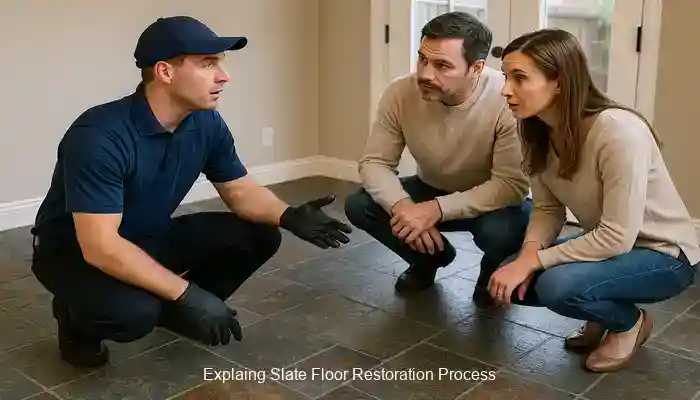
Last Updated on July 19, 2025 by David
Revitalize Your Living Space with Expert Slate Floor Restoration: Essential Techniques for Stunning Results
Explore the Unique Benefits and Characteristics of Slate Stone Flooring
Pro Tip: Essential Products for Daily Care of Your Slate Flooring
<a href=”https://www.abbeyfloorcare.co.uk/home-garden/slate-floor-repair-in-pilton/”>Slate</a> is an extraordinary metamorphic rock that is renowned for its exceptional durability and natural beauty. Its unique layering and rich color variations can greatly elevate the aesthetics of any interior, making it a highly desirable flooring option for both homes and commercial spaces. Across the United Kingdom, slate flooring adds character to historical buildings, contemporary residences, and quaint cottages, showcasing its intrinsic elegance. Its remarkable resistance to wear and tear ensures that slate remains a favored choice for high-traffic areas, reinforcing its status as a premier flooring option for discerning homeowners.
The distinct features of slate—often accentuated by its captivating grey, blue, and green tones—infuse a sense of sophistication into any room. This aesthetic appeal is matched by practical benefits; slate is naturally slip-resistant and effectively repels moisture, making it an ideal choice for high-use areas such as kitchens, bathrooms, and entryways. When properly maintained, slate floors can last for decades, if not centuries, exemplifying the stunning artistry of both nature and skilled craftsmanship.
To fully appreciate the value of slate, homeowners and restoration experts alike should explore the geological processes that give rise to this exquisite stone. The intricate balance of pressure, heat, and time yields this beautiful material, encapsulating a chapter of the Earth’s history. However, even the sturdiest slate floors can eventually be affected by time, wear, and insufficient maintenance, underscoring the increasing importance of expert slate floor restoration.
The Essential Importance of Professional Slate Floor Restoration for Lasting Beauty
The process of restoring slate floors transcends mere visual enhancement; it significantly boosts their functionality and prolongs their lifespan. Over time, slate can gather dirt, scratches, and stains that diminish its natural beauty. Investing in expert slate floor restoration can breathe new life into worn surfaces, allowing them to reclaim their original vibrancy. Once rejuvenated, the slate's inherent allure is restored, turning dull, lifeless floors into stunning centerpieces within any space.
Moreover, restoration is crucial not just for aesthetic uplift but also for maintaining the durability of your slate flooring. Overlooking minor issues can lead to more significant problems over time, such as moisture infiltration and structural damage. A well-executed restoration process not only rectifies visible imperfections but also strengthens the floor against potential future damage. By proactively addressing wear and tear, homeowners can avoid substantial replacement costs, which often surpass the expenses associated with restoration.
Additionally, a professionally restored slate floor can greatly enhance indoor air quality by removing trapped dust and allergens that may accumulate in damaged areas. This process acts as a proactive measure, ensuring that your investment in slate flooring continues to deliver benefits for many years to come. In terms of maintaining both beauty and functionality, expert slate floor restoration is undeniably a smart and valuable investment for discerning homeowners.
Conducting a Comprehensive Assessment of Your Slate Flooring’s Condition
Before initiating any restoration project, it is critical to conduct a thorough evaluation of your slate floor’s condition. This initial assessment should be carried out by a qualified professional skilled in identifying a variety of issues that may not be readily apparent to the untrained eye. Factors such as surface damage, previous treatments, and the overall structural integrity of the slate should be carefully evaluated.
Restoration specialists often employ specialized tools to closely examine the slate, looking for cracks, chips, or discoloration that may signal deeper problems. The condition of any existing sealant is also vital; if the sealant is compromised or worn, moisture can penetrate, resulting in further degradation. An experienced restoration expert can accurately diagnose these issues, providing tailored solutions that address both aesthetic and structural requirements.
Another crucial aspect of this evaluation is identifying the type of slate present. Different regions in the UK produce various slate types, each with unique properties and restoration needs. Recognizing the specific slate type can influence the choice of cleaning agents, sealants, and restoration methods. Understanding the condition of your slate is essential for ensuring that the restoration process is effective and sustainable.
Essential Preparatory Steps for Successful Slate Floor Restoration
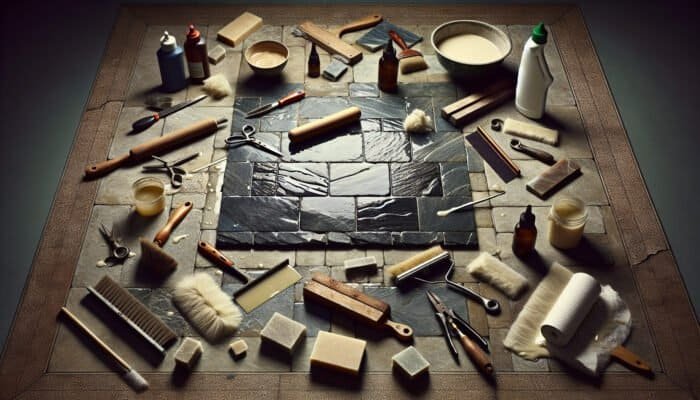
Clearing the Restoration Space for Optimal Access and Safety
Thorough preparation is the cornerstone of a successful restoration project. Before any cleaning or treatment begins, it is essential to remove all furniture, rugs, and other obstacles from the area. This vital step ensures that every inch of the slate floor is accessible while safeguarding your belongings from potential damage during the restoration process.
Completely clearing the floor establishes a safe and efficient workspace for professionals, allowing for a meticulous inspection of the slate surface and ensuring that no hidden issues go unnoticed. Additionally, removing items from the vicinity protects them from dust and debris that may accumulate during the cleaning and restoration phases, further safeguarding your possessions.
Once the area is cleared, it can be beneficial to assess the layout of the space. This may involve identifying areas most affected by wear and tear, enabling targeted restoration efforts. For example, high-traffic zones may require additional focus to ensure comprehensive restoration. This preparatory stage is vital for laying the groundwork for a successful restoration, ensuring that the professional team can operate efficiently and effectively.
Thorough Cleaning and Surface Preparation Techniques for Slate Floors
The restoration process begins with an extensive cleaning of the slate surface. This initial step is critical for eliminating layers of dirt, grime, and residues left by previous cleaning products. Professionals generally use a combination of gentle yet effective cleaning agents that are safe for slate, ensuring that the stone remains undamaged throughout the process.
Utilizing appropriate tools is essential. High-quality mops, brushes, and vacuum cleaners specifically designed for stone surfaces can significantly enhance the cleaning process. The goal is to create a clean slate—literally—before proceeding to more in-depth restoration treatments. Once the surface is clean, it is imperative to allow it to dry completely. Any moisture trapped beneath restoration products can lead to complications; hence, patience during this phase is critical for a successful outcome.
Preparation also involves checking for any loose tiles or sections that may require further attention. Addressing these concerns before initiating restoration efforts can save both time and resources. Ensuring that the surface is adequately prepared sets the stage for successful honing, polishing, and sealing, which are the subsequent steps in the restoration journey.
Implementing Essential Safety Measures During the Slate Floor Restoration Process
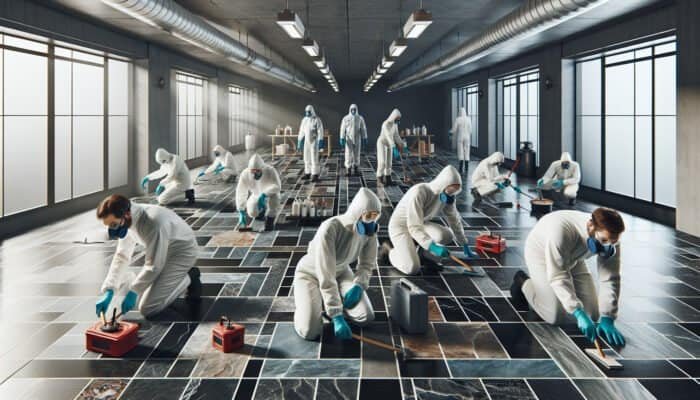
In any restoration project, prioritizing safety is of utmost importance. Proper safety protocols not only protect the well-being of those working on the slate floor but also preserve the integrity of the materials involved. Wearing protective gear such as gloves, masks, and goggles shields against dust, chemicals, and other potential hazards associated with floor restoration.
Ventilation is another critical aspect of safety. Ensuring that the workspace is well-ventilated helps to disperse any fumes from cleaning agents or sealants, creating a safer environment. If the area lacks natural airflow, professionals should consider using fans or air purifiers to enhance circulation, ensuring a comfortable and safe working atmosphere.
Additionally, it is essential to be mindful of the tools and equipment being utilized during the restoration process. Ensuring that all tools are in proper working condition reduces the risk of accidents. Professionals should be adequately trained in the correct handling and operation of their equipment. A commitment to safety not only protects individuals but also contributes to a smoother, more efficient restoration process.
Advanced Techniques for Effective Slate Floor Restoration
Mastering Honing and Polishing for an Impeccable Slate Finish
Honing and polishing are fundamental techniques employed in the restoration of slate floors. Honing involves grinding the surface of the slate using specialized diamond pads, effectively smoothing out imperfections and scratches. This process not only enhances the stone’s aesthetic appeal but also prepares it for the polishing phase, which elevates the finish to a new level.
The advantages of honing are two-fold. Firstly, it assists in eliminating surface stains and blemishes that may have accumulated over time. Secondly, it creates a more uniform surface, which is essential for achieving that sought-after glossy finish during the polishing phase. Many homeowners are often surprised to discover that honing can dramatically transform the appearance of their slate floors, restoring the vibrancy that initially attracted them to the stone.
Following honing, the polishing process elevates the floor’s finish to a new level. By using finer diamond pads, the slate is polished to reveal its natural shine. This step not only enhances the visual appeal but also adds a protective layer, making the slate more resistant to stains and wear. The result is a beautifully restored floor that feels as luxurious as it looks.
It’s important to note that these techniques demand expertise. Professionals possess the knowledge to determine the appropriate level of honing and polishing required based on the slate’s condition. Over-polishing or employing incorrect techniques can lead to additional damage, so relying on experienced professionals for this phase is essential for optimal results.
Expert Techniques for Repairing Cracks and Chips in Slate Flooring
Cracks and chips are common occurrences in slate flooring, particularly in high-traffic areas. Promptly addressing these concerns is vital for maintaining the structural integrity of the floor. Professional restoration services utilize specialized techniques and materials to effectively repair these damaged areas, ensuring that the slate remains both functional and visually appealing.
The initial step in repairing cracks and chips involves evaluating the extent of the damage. Minor chips can often be filled with a resin or epoxy specifically formulated for slate. This material not only fills the chip but also bonds with the surrounding slate, providing a seamless appearance. For larger cracks, more extensive repairs might be necessary, which may include using additional slate pieces or composite materials to restore the area.
Once repairs are completed, professionals typically apply a finishing treatment that blends with the existing slate. This step is crucial for achieving a uniform appearance across the entire floor. The result is a beautifully restored surface where imperfections have been expertly addressed, allowing the floor to continue serving as a stunning focal point in your home.
Investing in crack and chip repair as part of the expert slate floor restoration process not only enhances the beauty of the slate but also extends its lifespan. By ensuring that the floor is free of damage, homeowners can enjoy their elegant slate floors without concerns regarding further deterioration or structural issues.
Utilizing Advanced Techniques for Efficient Stain Removal on Slate Floors
Stain removal is a vital component of the slate floor restoration process, as stains can significantly detract from the stone’s natural beauty. Various types of stains can occur, ranging from food and beverage spills to moisture-related discoloration. The key to effective stain removal lies in accurately identifying the type of stain and applying the appropriate cleaning methods tailored to the specific issue.
Several types of stains are commonly found on slate floors. Organic stains, such as those caused by coffee or red wine, require specific cleaning agents that break down the organic material without harming the slate. Conversely, inorganic stains—like rust or mineral deposits—often necessitate harsher chemical treatments. Professionals are well-equipped to identify these stains and utilize the right solutions to tackle them effectively and efficiently.
It is important to note that most stain removal processes involve more than merely applying a cleaner. Professionals often employ techniques such as poulticing, where a special paste is applied to the stain to draw it out from the slate. This method can be exceptionally effective, particularly for deeply embedded stains that standard cleaning cannot eliminate, ensuring a thorough and successful cleaning process.
After the stain removal process is complete, a thorough rinse and drying phase is crucial to ensure no cleaning residues remain. This step not only enhances the slate’s appearance but also prepares the surface for sealing, which helps prevent future stains from becoming entrenched and damaging the stone.
Sealing and Protecting Your Slate Floors for Long-Lasting Beauty
Selecting the Right Sealant for Comprehensive Slate Floor Protection
Choosing the appropriate sealant is a fundamental step in the restoration process, as it provides critical protection for your slate floors against stains, moisture, and general wear. The market offers a variety of sealants, each with unique properties, making it essential to select one that aligns with your specific needs and the characteristics of your slate.
One crucial element when selecting a sealant is the level of porosity of your slate. Different slate types absorb sealant differently, so consulting with a professional to determine the best option is advisable. Some sealants are designed for high-traffic areas, providing superior protection, while others may focus on enhancing the natural color and texture of the stone.
Water-based sealants generally tend to be less toxic and easier to apply, making them a popular choice for residential applications. These sealants penetrate the slate, creating an invisible barrier that blocks moisture and stains. In contrast, solvent-based sealants offer a more robust defense, often lasting longer but requiring extra caution during application due to their stronger odors, ensuring a safe working environment.
Choosing the right sealant not only guarantees that your slate floors are beautifully protected but also simplifies future maintenance. A quality sealant can make cleaning more manageable, as spills are less likely to penetrate the surface. Investing in a top-notch sealant and professional application reinforces your commitment to preserving the beauty and integrity of your slate floor for years to come.
Correct Application Techniques for Maximum Sealant Effectiveness
Applying sealant correctly is just as critical as selecting the right product. The application process involves thoroughly cleaning and drying the slate to ensure that no contaminants interfere with the sealant’s adhesion. Professionals typically utilize rollers or brushes to distribute the sealant uniformly across the surface, providing comprehensive coverage and protection.
A key aspect of sealant application is the drying time. Each sealant has a specific curing time, and it is essential to adhere to the manufacturer’s instructions meticulously. Rushing this process can lead to uneven patches or a compromised protective layer. Professional restorers understand the significance of patience in this step, ensuring that the sealant adheres properly and cures effectively for optimal performance.
After the initial application, a second coat may be necessary to achieve the desired level of protection. This is particularly relevant for outdoor slate or high-traffic areas where additional durability is essential. Professionals will evaluate the floor and recommend the optimal approach to achieving a long-lasting finish that ensures your slate remains stunning.
The result of a well-executed sealant application is a slate floor that is not only visually stunning but also fortified against everyday wear and tear. A properly sealed floor can resist stains and moisture, allowing homeowners to enjoy their beautiful slate surfaces without constant worry about damage.
Establishing Essential Maintenance Routines After Sealing for Longevity
Once your slate floors have been restored and sealed, establishing a regular maintenance routine is crucial for preserving their beauty and functionality. Consistent upkeep will ensure that the sealant remains effective, preventing dirt and grime from penetrating the slate and causing damage over time.
Routine maintenance involves simple tasks such as sweeping and mopping with gentle cleaning solutions that are safe for slate. Avoiding harsh chemicals is vital, as they can break down the sealant, leading to premature wear and requiring more frequent reapplication. Additionally, placing doormats at entrances can assist in trapping dirt and debris before it reaches the slate floor, thereby reducing the frequency of deep cleaning required.
It’s also essential to monitor the condition of the sealant over time. If you notice any signs of wear or discoloration, it may be time to apply a new coat of sealant. Conducting regular assessments of the floor can help identify any potential issues early on, allowing for prompt action to maintain the slate’s integrity and appearance.
Investing time in maintenance after sealing can significantly extend the lifespan of your slate floors, protecting both your investment and the beauty of your home. Regular care ensures that your slate flooring continues to be a stunning feature in your space, serving as a testament to the elegance and durability that slate offers.
Understanding Resealing Frequency for Optimal Care and Maintenance
Understanding how often to reseal your slate floors is crucial for maintaining their appearance and protection. Various factors, including foot traffic, the type of sealant used, and environmental conditions, can influence how frequently resealing is necessary. Generally, homeowners should anticipate resealing every 1-3 years to ensure continued protection.
In high-traffic areas, such as hallways or kitchens, resealing may be required sooner, as wear and tear can compromise the protective layer more rapidly. Conversely, slate floors in low-traffic areas may retain their sealant for a longer duration. Monitoring the condition of the sealant can guide your resealing schedule. Signs that it may be time for a new coat include discoloration, dullness, or stains that seem to penetrate the surface.
Professional restoration services often provide guidance on resealing frequency based on the type of slate and usage patterns. Regular checks by professionals can also help ensure that your slate flooring remains in optimal condition, ultimately saving on costly repairs or replacements in the future.
Maintaining a schedule for resealing your slate floors ensures that their beauty remains intact while also prolonging their lifespan. By staying proactive, you can enjoy the elegance and durability of slate flooring without the worry of premature deterioration.
Promptly Addressing Common Sealant Issues for Optimal Performance
Even with careful application and maintenance, sealant issues can occasionally arise. Common problems include peeling, discoloration, and efflorescence, which can detract from the beauty of your slate floors. Understanding how to troubleshoot these issues is crucial for preserving the floor’s integrity and aesthetics.
Peeling sealant often occurs when the surface was not adequately prepared prior to application. If you notice peeling, it is crucial to remove the damaged sealant, clean the surface thoroughly, and reapply an appropriate sealant. Discoloration may indicate that the sealant has deteriorated, often due to moisture exposure or harsh cleaning products. In such cases, a professional assessment can help determine the best course of action to restore the floor’s appearance and functionality.
Efflorescence, a white powdery substance, is another common issue that can affect slate floors. This occurs when moisture evaporates from the slate, leaving behind mineral deposits. Removing efflorescence typically involves using specific cleaning agents designed to break down these deposits without harming the slate, ensuring a thorough and effective cleaning process.
Addressing sealant issues promptly not only protects the slate’s appearance but also helps preserve its structural integrity. Regular monitoring and immediate action can prevent minor problems from escalating, ensuring that your slate floors continue to shine beautifully for years to come.
Overcoming Common Challenges in Slate Restoration: Effective Strategies
Effectively Managing Efflorescence on Slate Floors for Optimal Aesthetics
Efflorescence is a challenge that many slate floor owners encounter, particularly in areas with high humidity or moisture exposure. This white, powdery substance appears when moisture evaporates from the slate, leaving behind mineral deposits that can mar its appearance. Addressing efflorescence swiftly is vital for maintaining the beauty of your slate floors.
Removing efflorescence typically requires the use of specialized cleaning agents designed to dissolve mineral deposits without damaging the slate. Professionals often employ a two-step approach: first, they will apply a cleaning solution to the affected areas, followed by thorough rinsing to ensure no residues remain, ensuring a clean and visually appealing surface.
In addition to cleaning, addressing the underlying moisture issue is crucial. This may involve enhancing ventilation in the area or implementing moisture barriers to prevent excess water from reaching the slate. By tackling both the symptoms and the root cause of efflorescence, homeowners can effectively protect their slate floors from further damage and maintain their aesthetic appeal.
Persistent efflorescence can indicate a more significant moisture intrusion problem, which may require professional evaluation. Ignoring this challenge can lead to long-term damage to the slate, making prompt action vital for preservation and aesthetic maintenance.
Correcting Uneven Wear Patterns on Your Slate Floors for Safety and Aesthetics
Uneven wear on slate floors is another common challenge, particularly in areas with high foot traffic. Over time, certain spots may become more worn than others, leading to an unattractive appearance and potential safety hazards. Promptly addressing uneven wear is crucial for maintaining the slate’s beauty and functionality.
Professional restoration services employ various techniques to rectify uneven wear, including grinding and polishing. Grinding involves utilizing specialized equipment to level the surface, effectively evening out worn areas. This method not only restores the slate’s appearance but also prepares it for subsequent polishing, which enhances shine and protection.
After grinding, polishing is an essential phase that revitalizes the slate’s vibrancy. Using finer diamond pads, professionals can achieve a smooth, glossy finish across the entire surface, ensuring uniformity and visual appeal. The result is a beautifully restored slate floor that not only looks stunning but also improves safety by providing a consistent walking surface.
Addressing uneven wear not only revitalizes the floor but also extends its lifespan. Regular maintenance and attention to high-traffic areas are vital for preventing further wear and ensuring that the slate continues to be a gorgeous and functional feature in your home.
Proactive Strategies for Preventing Future Damage to Slate Floors
Preventing future damage to restored slate floors is a key concern for homeowners. Taking proactive measures can significantly enhance the longevity of your slate, saving you time and money in the long run. Regular maintenance, coupled with protective strategies, can keep your slate floors looking their best for years to come.
Implementing a cleaning routine is the first step in prevention. Regular sweeping and mopping with gentle cleaning products suitable for slate can help eliminate dirt and debris before they cause damage. Additionally, placing mats at entryways can trap dirt and moisture, reducing wear caused by foot traffic and protecting the slate’s surface.
Another crucial aspect of prevention involves monitoring the condition of the sealant. Regular inspections can help identify any signs of wear or damage, allowing homeowners to take timely action before more significant issues arise. Resealing the slate as recommended ensures that it maintains its protective barrier against stains and moisture, preserving its beauty.
Finally, addressing spills immediately is vital. Promptly cleaning up any liquid spills can prevent stains from setting and protect the integrity of the slate. By fostering a culture of care and attention to detail, homeowners can ensure their slate floors remain a stunning focal point in their homes for generations to come.
Finding the Right Professional Slate Restoration Services
Identifying Key Qualities in a Trustworthy Restoration Company
When searching for professional slate restoration services, it’s imperative to select a company that embodies expertise and quality. Several key characteristics can indicate a reliable restoration provider. Firstly, experience is crucial. Companies with a proven track record in slate restoration are more likely to understand the nuances of various slate types and the specific challenges that may arise during the restoration process.
Certifications and training also play a pivotal role in identifying a reputable restoration company. Seek out professionals who are certified by recognized industry organizations, as this often signifies a commitment to quality and best practices in restoration techniques. Positive customer reviews serve as another indicator of a company’s reliability; these testimonials can provide valuable insight into the level of service and satisfaction previous clients have experienced.
Effective communication is equally important. A good restoration company should be willing to discuss the restoration process in detail, provide clear timelines, and outline costs upfront. Transparency fosters trust, ensuring that homeowners feel confident in their choice of service provider. By taking the time to research and vet restoration companies, you can find a trusted partner for your professional slate floor restoration needs.
Preparing for the Detailed Slate Floor Restoration Process: What to Expect
Understanding what to expect during the restoration process can help set realistic expectations for homeowners. Typically, the process begins with an initial assessment, during which professionals identify the specific needs of the slate floor and recommend an appropriate course of action tailored to the condition of the stone.
Following the assessment, the restoration team will clear the area in preparation for cleaning and treatment. This phase involves thorough cleaning, honing, and polishing, which may take several days depending on the floor’s condition and size. Homeowners should be prepared for potential disruptions during this time, as access to the area may be limited, necessitating adjustments in daily routines.
Throughout the process, effective communication is paramount. A reputable restoration company will keep homeowners informed about progress and any unexpected issues that may arise. This transparency helps ensure that the restoration meets the homeowner’s expectations and maintains their satisfaction.
Finally, after the restoration is completed, professionals will provide guidance on maintenance and care to keep the slate looking its best. Understanding the full scope of the restoration process allows homeowners to appreciate the effort involved and the transformations that take place, ensuring their satisfaction with the results.
Key Factors Influencing Restoration Costs: Essential Considerations
The cost of slate floor restoration can vary significantly based on several factors. The size of the area being restored, the extent of damage, and the specific restoration techniques required all influence the overall cost of the project. Typically, larger areas or floors with more severe damage necessitate more time and resources, thereby increasing the price.
Additionally, the type of slate can impact restoration costs. Certain slate types may require specialized care or techniques, which can affect pricing. For instance, unique or rare slate varieties may necessitate more expensive materials or methods to restore effectively.
Homeowners need to obtain detailed quotes from restoration companies. These quotes should outline the specific services included and any potential additional costs. While it may be tempting to choose the lowest price, prioritizing quality and expertise is crucial for achieving satisfactory results and ensuring a successful restoration.
Investing in professional slate floor restoration can yield long-term benefits. A beautifully restored slate floor can enhance property value, improve aesthetics, and reduce the likelihood of future repair costs. Understanding the factors that influence restoration costs enables homeowners to make informed decisions about their investments in slate flooring.
The Advantages of Choosing Local Expertise for Slate Restoration Services
Opting for a local restoration company for slate floor restoration offers distinct advantages. Local professionals often possess in-depth knowledge of regional slate types, comprehending the unique properties and challenges associated with them. This expertise ensures that the restoration process is tailored specifically to the materials present in your home, enhancing the effectiveness of the restoration.
Moreover, local companies are more accessible for consultations and follow-up services. Building a relationship with a nearby restoration provider can foster trust and open lines of communication, making the entire process more efficient and enjoyable for both parties.
Local professionals frequently understand the environmental conditions in your area that can impact slate flooring, such as humidity levels, which can lead to moisture-related issues. This regional expertise can guide homeowners in making informed decisions about the care and maintenance of their slate floors, further enhancing their longevity and appearance.
Furthermore, supporting local businesses contributes positively to the community’s economy, creating a win-win situation for homeowners and local professionals alike. By choosing a local restoration company, you not only benefit from their expertise but also contribute positively to your community’s growth and sustainability.
Frequently Asked Questions About Slate Floor Restoration
What does the comprehensive slate floor restoration process involve?
Slate floor restoration encompasses cleaning, repairing, and sealing slate flooring to enhance its aesthetic appeal and longevity. This thorough process addresses wear, stains, and scratches, effectively restoring the slate to its original beauty and functionality.
How frequently should I schedule my slate floors for restoration?
The frequency of restoration depends on foot traffic, the condition of the slate, and maintenance routines. Generally, professional restoration is recommended every 1-3 years to maintain the slate's appearance and integrity.
Can I clean my slate floors on my own?
While light cleaning can be performed at home, professional cleaning is advisable for deep cleaning and restoration to avoid damaging the slate with harsh chemicals or improper techniques. Engaging professionals ensures the best results.
What types of stains are typically found on slate floors?
Slate floors can experience various stains, including organic stains from food or drinks, inorganic stains from rust or mineral deposits, and moisture-related discoloration that can compromise the stone’s beauty.
How can I select a trustworthy restoration company?
Seek a restoration company with extensive experience, proper certifications, positive customer reviews, and strong communication skills. Assess their expertise specifically in working with slate flooring to ensure you receive quality service.
What steps should I take if my sealant starts to peel?
If the sealant is peeling, it is advisable to remove the damaged area, clean the slate thoroughly, and reapply a suitable sealant to ensure proper protection and appearance, maintaining the integrity of your slate floors.
Is slate flooring a good choice for kitchens and bathrooms?
Yes, slate flooring is an excellent option for kitchens and bathrooms due to its moisture resistance and slip-resistant qualities, making it both safe and stylish for high-use areas.
What steps can I take to prevent future damage to my slate floors?
Regular maintenance, immediate clean-up of spills, using doormats, and ensuring proper sealing will help prevent future damage and preserve the beauty of your slate flooring for years to come.
What is the best way to maintain newly restored slate floors?
Regular sweeping and mopping with gentle cleaning agents are essential. Avoid harsh chemicals, and ensure you reseal the floors as recommended to preserve their beauty and functionality over time.
Can I undertake slate floor restoration as a DIY project?
While certain aspects can be managed DIY, such as regular cleaning, professional assistance is advisable for comprehensive restoration to ensure optimal techniques and materials are used for the best results.
The Article Professional Slate Floor Restoration: Expert Techniques first found on https://www.abbeyfloorcare.co.uk
The Article Slate Floor Restoration: Mastering Expert Techniques appeared first on https://fabritec.org
The Article Slate Floor Restoration Techniques: A Master’s Guide Was Found On https://limitsofstrategy.com
The Article Slate Floor Restoration Techniques for Optimal Results First Appeared ON
: https://ad4sc.com
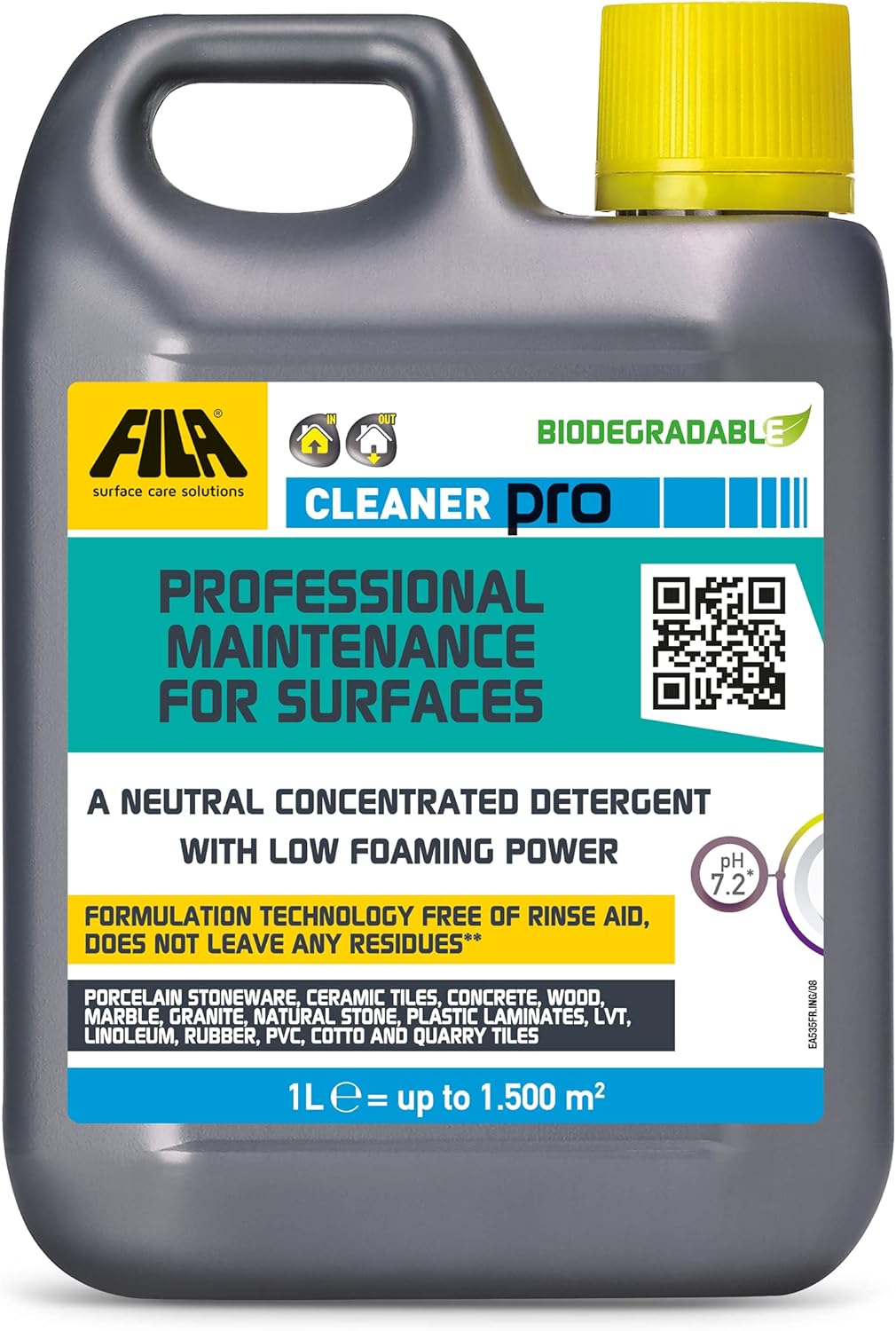
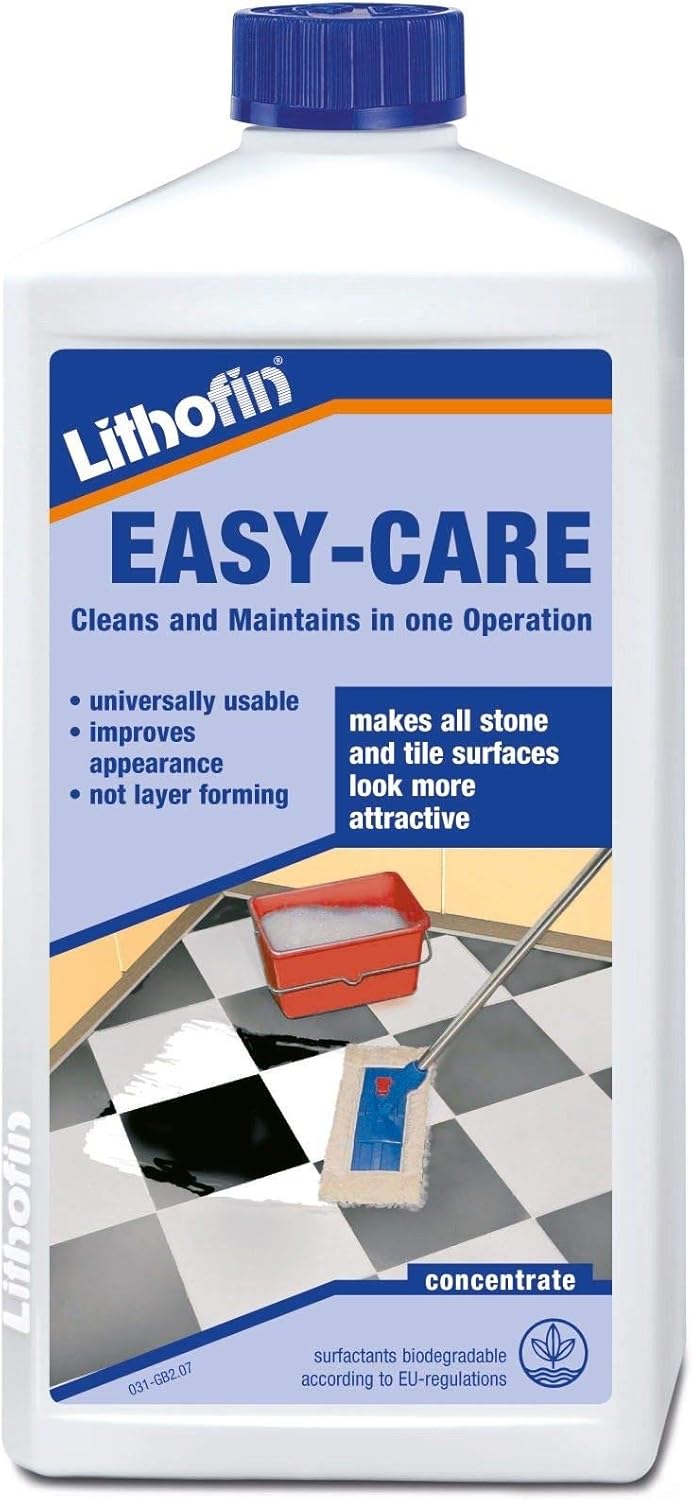
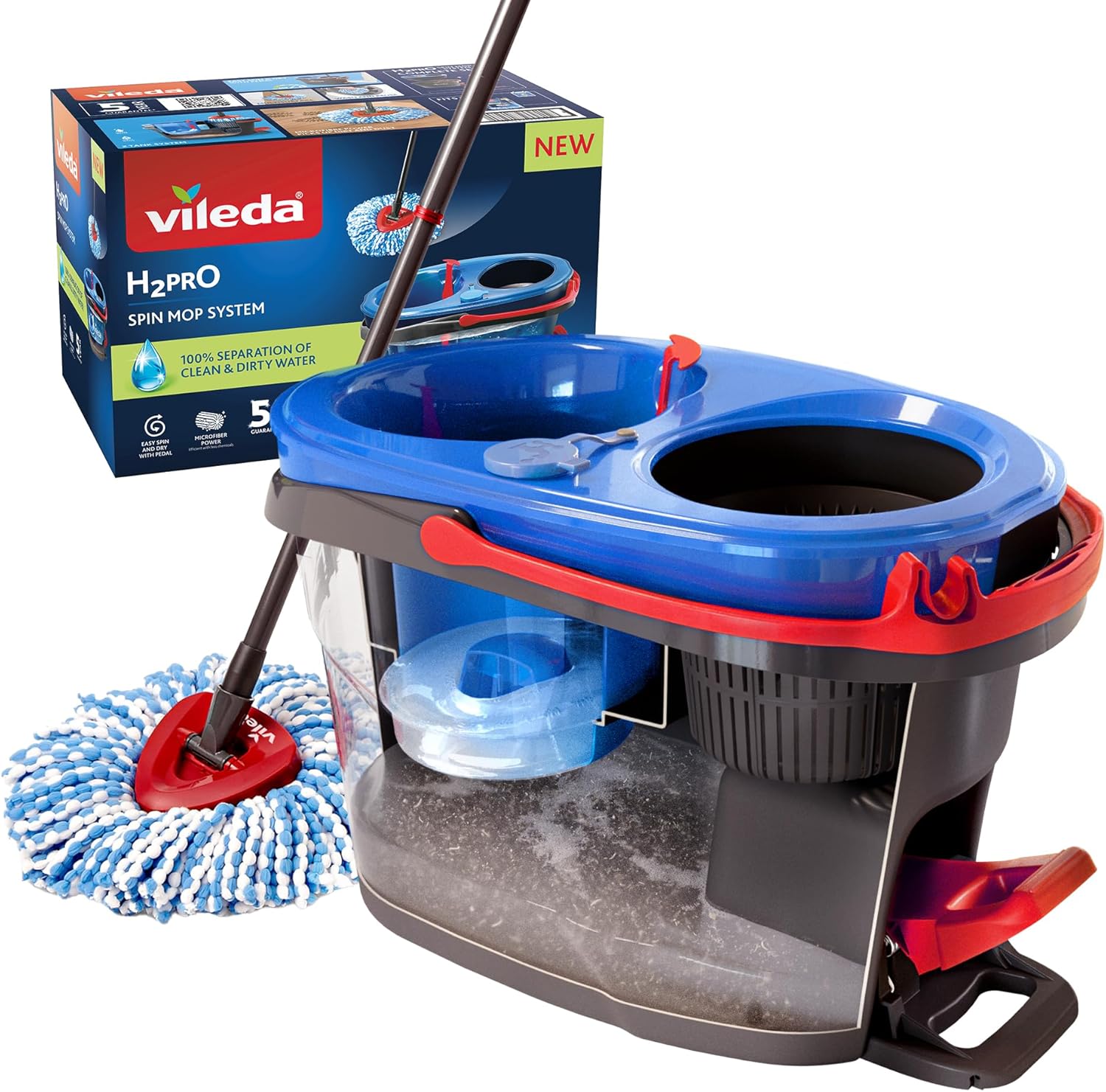





No responses yet